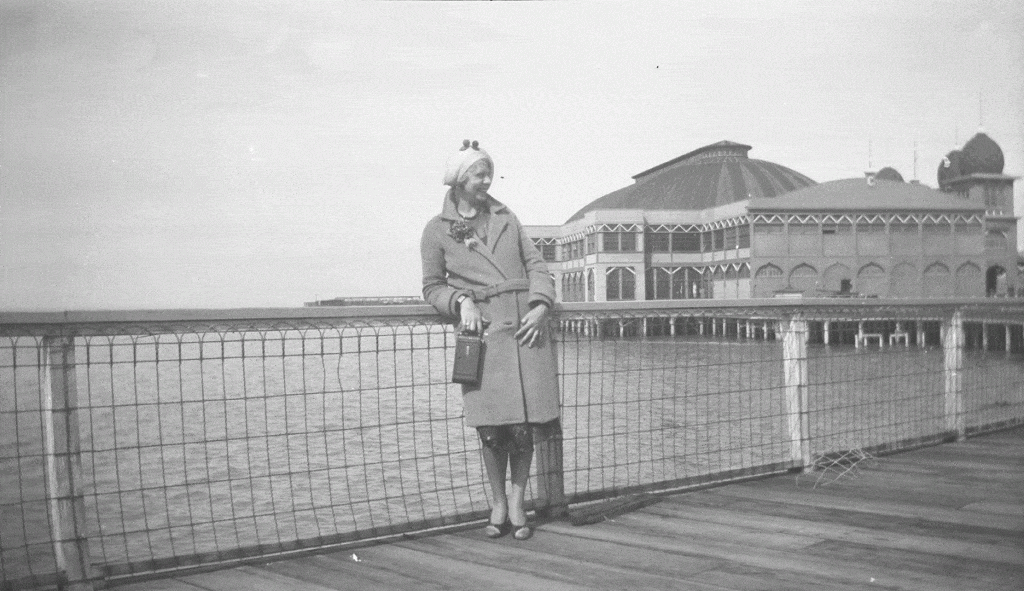In June 1946, Park City restaurateur J.E. Jenkins, also known as photographer Pop Jenks, decided to treat his employees and their families to an outing at the beach. Yes, the beach. In those days if you wanted to play in the waves and dance to the music of a big band, you headed for Saltair on the south shore of Great Salt Lake. “The day started with all going in swimming, followed by a lunch,” the Park Record reported. “The evening was spent dancing to the music of Al Donahue’s orchestra.”
Today we turn up our noses, literally, at the thought of sharing the waves with brine flies. But, between 1870 and 1960, the resorts along the lake were the closest thing to Coney Island that Utahns had. Saltair was even advertised as the “Coney Island of the West.”
In their 1993 book “Saltair,” Nancy and John McCormick describe how the “strange salty sea” attracted early immigrants, journalists and other professional travelers. “After a swim during his visit in 1863 journalist Fitz Hugh Ludlow whimsically concluded that he felt the ‘pleasant sense of being a pickle, such as a self-conscious gherkin might experience,’” the McCormicks wrote.
Encouraged by the construction of local railroad lines, the first two resorts – Lake Side and Lake Point – opened in 1870. From Lake Side you could ride around the lake on a three-deck stern-wheel steamboat. Other resorts followed.
Then, in 1893, came Saltair, the most elaborate and expensive of them all. Financed by the Mormon Church and designed by renowned local architect Richard Kletting, “Saltair was an architectural wonder,” the McCormicks said. The central pavilion measured about 250 by 140 feet and reached more than 100 feet high. It was surrounded by mosque-like towers topped with onion-shaped domes.
Initially, Saltair’s big attractions were swimming and dancing. By 1914 the resort also boasted a roller coaster. In 1919, Saltair attracted 450,000 people.
In April 1925, Saltair was gutted by fire. However, new owners moved quickly to rebuild, borrowing from Kletting’s original Moorish design. Saltair II opened in May 1926. It was this rendition that Pop Jenks and his employees visited 20 years later.

Credit: Park City Historical Society & Museum, Thomas F. Hansen Collection
Facing stiff competition from Lagoon and other attractions, Saltair’s owner donated the resort to the state in 1959. Saltair was closed, the buildings deteriorated, and fire destroyed what was left in November 1970.
In the early 1980s, Utah businessmen bought an abandoned airplane hangar, moved it to Saltair and added a façade recalling the original design. However, Saltair III has never matched the appeal of its predecessors.
The Park City Museum just wrapped up an exhibit celebrating the Saltair of the East, better known as Coney Island, NY.
6 Comments
My father was a young child when saltair was still open and running. He had a job working there at one point. His job was to play music for one of the amusement rides on a piano, playing the same little ditty over and over until the ride stopped, just to do it all over again for every turn. When I was a young child, he taught me how to play this song, and I still remember every note of it to this day. My father is 84 now, and as he approaches the end of his life, I have a strong desire to share this song with anyone who can and wishes to preserve it as part of the history of saltair. This article is the best resource I’ve found on the subject of utah’s saltair, and as a museum, I couldn’t find anyone better to reach out to about it. If this is of interest to the museum, please reach out to me with the email provided. Thank you!
HI Brady,
I am writing a book on Saltair. I’d love to here the song your Father used to play at the resort.
Brady,
I am a student researcher gathering information on Saltair for a National History Fair. I would love to know more about his story and song.
I spent my life from about 6yrs old to the closing at the resort and would love to talk to you and maybe get a copy of your work
I am looking for information on Garfield Beach and the Ghost town of Garfield. Any info would be appreciated.
Thank you
I travelled through Salt Lake City on I-80 in 1984. When I saw Saltair it was almost submerged in the Lake. I saw a railroad track that extended off into the Lake as well as the the top loops of a roller coaster. They were also rebuilding part of I-80 as it had been washed out in April of that year. Very eerie area at that time.